
South America: Galapagos Outer Loop Cruise - 2025
Celebrity Cruises
In the Galapagos, modern explorers come eye to eye with ancient tortoises, comical birds, and other amazing beasts — plus landscapes as fantastical as the animals — for a once-in-a-lifetime adventure. For seven glorious days, you'll follow in the footsteps of Darwin, viewing this realm through the eyes of certified naturalists, in small groups of travelers who share your interests.

Executive Member Benefit
Executive Members receive an annual 2% Reward, up to $1,250, on qualified Costco Travel purchases
Digital Costco Shop Card
Member Exclusive: Digital Costco Shop Card with every Celebrity Cruises sailing†
Onboard the Celebrity Flora
Celebrity Flora
Year Built: 2018
Double Occupancy Capacity: 100
Celebrity Flora® marks an evolutionary turning point in the approach to ship design—creating a sense of being truly immersed in the destination, instead of just visiting it. Indulge in the largest and most luxurious accommodations in the Galapagos Islands, where every stateroom on board is a suite. Dine on delectable menus, curated by a Michelin-starred chef, and allow your Personal Suite Attendant to help you unpack. All this to ensure that your visit to these primitive islands is anything but.
Activities & Services (included in cruise)
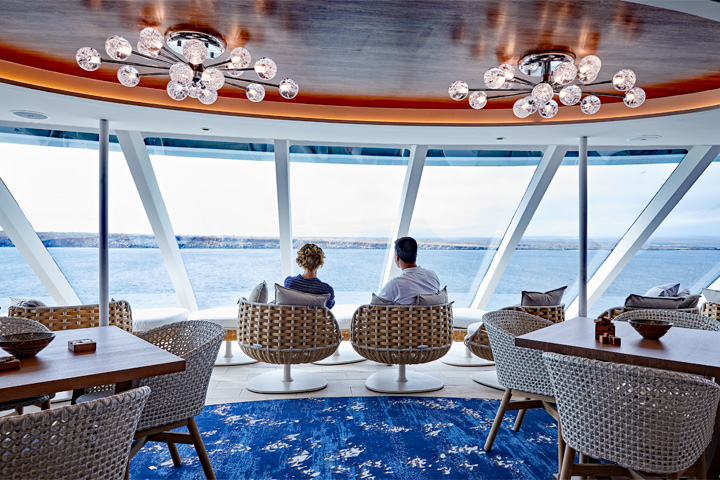
Observatory
- Fitness Center
- Sauna/Steam Room
- Water Sports Platform
- Whirlpool/Jacuzzi
- Bars/Lounges
- Library
- Concierge Desk
- Elevators
- Safe Deposit Boxes
Activities & Services (available for an extra fee)

Jacuzzi
- Full-Service Spa
- Dry Cleaning/ Laundry Service
- Duty-Free Shops/Boutiques
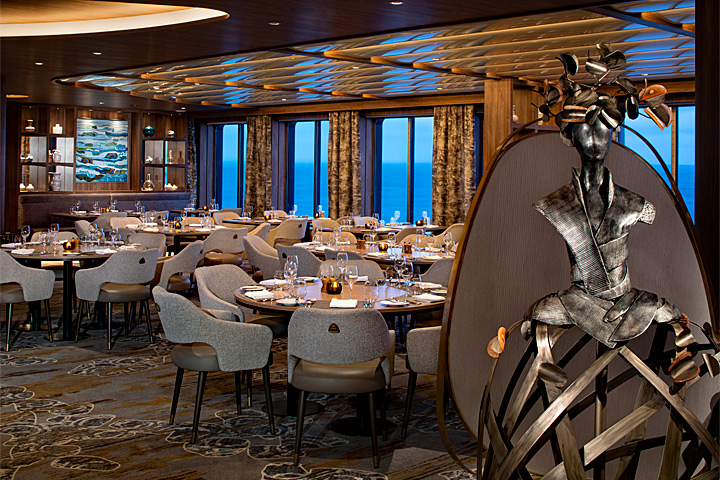
Seaside Restaurant
Main Dining
Seaside Restaurant: Experience a culinary journey in the Galapagos in the Seaside Restaurant. It's a spacious "barefoot chic" space that features destination-inspired design elements and floor-to-ceiling windows throughout for stunning vistas that complement the mouthwatering meals you'll enjoy here—morning, noon, and night.
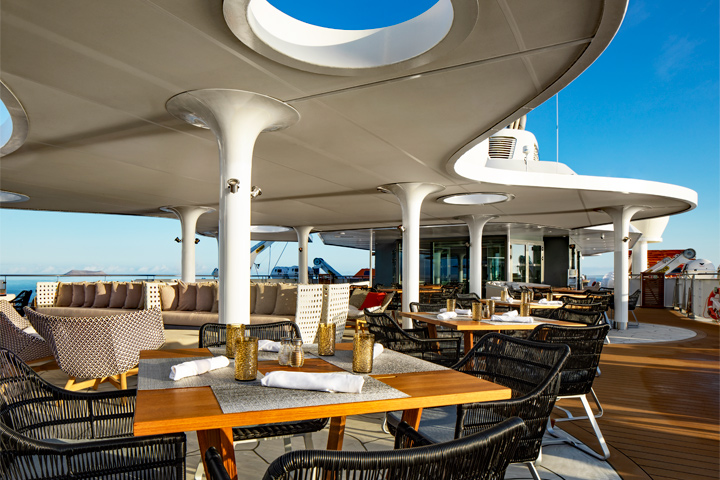
Ocean Grill
Casual Dining
Ocean Grill Restaurant: Ocean Grill is an outdoor casual restaurant that offers panoramic views during the day and stunning, starlit skies at night. Here, there's every opportunity to enjoy both the destination and our culinary expertise daily. From grilling up the highest quality, sustainable seafood from the area for lunch to what we like to call Dinner Under the Stars, Ocean Grill is the envy of any destination restaurant around.
Suites feature a private balcony, complimentary sparkling wine, use of snorkel equipment and wetsuits, and much more.
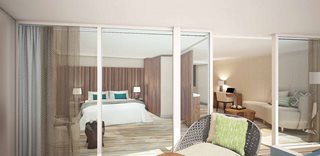
Category: W
This category can be booked for a special rate, guaranteed to you. Please note that the category is not associated at the time of booking with a specific stateroom, deck, bedding configuration or other particular settings. The assignment of an actual cabin will be performed during your check-in. The cabin can be anywhere on the ship.
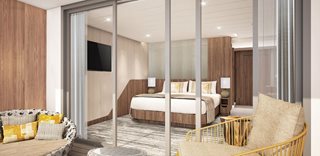
Category: S1
Amenities- Complimentary premium refillable water bottle
- Daily delivery in-suite delectable
- Customized mini-bar offering
- Champagne / sparkling wine upon arrival
- Complimentary backpack
- Complimentary rain poncho
- Stationery
- Use of high-end marine binoculars
- Ecuadorian chocolates
- Use of sunglasses and readings glasses
- Local high-end, eco-friendly, organic bath amenities cooling gel, lip balm, sunscreen
- Spacious veranda
- Outward facing design
- King-sized bed
- Spacious shower
- Full Suite automation
- Double faucet vanity with stone countertop
- In-suite filtered water refilling station
- Premium linens and pillow menu
- Extensive offering of live and on demand TV programming and movies
- Personal Suite Attendant
- Laundry service twice per sailing
- 24-hour in suite room service
- Full in-suite dinner service
- Laundry service twice per sailing*
- Makeup and turndown services
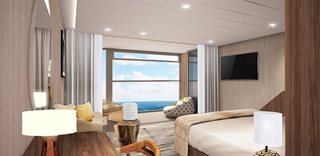
Category: SK
Amenities- Complimentary premium refillable water bottle
- Daily delivery in-suite delectable
- Customized mini-bar offering
- Champagne / sparkling wine upon arrival
- Complimentary backpack
- Complimentary rain poncho
- Stationary
- Use of high-end marine binoculars
- Ecuadorian chocolates
- Use of sunglasses and readings glasses
- Local high-end, eco-friendly, organic bath amenities cooling gel, lip balm, sunscreen
- Outward-facing design
- Infinite Veranda
- King-sized bed
- Spacious shower
- Full Suite automation
- In-suite filtered water refilling station
- Premium linens and pillow menu
- Double-faucet vanity with stone countertop
- Extensive offering of live and on demand TV programming and movies
- Personal Suite Attendant
- 24-hour in-suite room service
- Full in-suite dinner service
- Makeup and turndown services
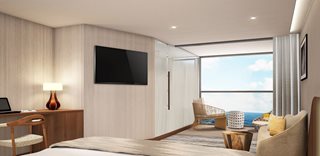
Category: SP
Amenities- Complimentary premium refillable water bottle
- Daily delivery in-suite delectable
- Customized mini-bar offering
- Champagne / sparkling wine upon arrival
- Complimentary backpack
- Complimentary rain poncho
- Stationery
- Use of high-end marine binoculars
- Ecuadorian chocolates
- Use of sunglasses and readings glasses
- Local high-end, eco-friendly, organic bath amenities cooling gel, lip balm, sunscreen
- Outward-facing spacious spa tub and shower
- Infinite Veranda
- King-sized bed
- Full Suite automation
- In-suite filtered water refilling station
- Premium linens and pillow menu
- Extensive offering of live and on demand TV programming and movies
- Personal Suite Attendant
- Laundry service twice per sailing
- 24-hour in-suite room service
- Full in-suite dinner service
- Laundry service twice per sailing
- Makeup and turndown services

Category: SU
Amenities- Complimentary premium refillable water bottle
- Daily delivery in-suite delectable
- Customized mini-bar offering
- Champagne / sparkling wine upon arrival
- Complimentary backpack
- Complimentary rain poncho
- Stationery
- Use of high-end marine binoculars
- Ecuadorian chocolates
- Use of sunglasses and readings glasses
- Local high-end, eco-friendly, organic bath amenities cooling gel, lip balm, sunscreen
- Outward-facing spacious spa tub and shower
- Infinite Veranda
- King-sized bed
- Private refrigerator
- In-suite safe
- Full Suite automation
- In-suite filtered water refilling station
- Premium linens and pillow menu
- Extensive offering of live and on demand TV programming and movies
- Personal Suite Attendant
- Laundry service twice per sailing
- 24-hour in-suite room service
- Full in-suite dinner service
- Laundry service twice per sailing
- Makeup and turndown services

Category: RS
Amenities- Robes with optional personalization
- Complimentary premium refillable water bottle
- Daily delivery in-suite delectable
- Customized mini-bar offering
- Champagne / sparkling wine upon arrival
- Complimentary backpack
- Complimentary rain poncho
- Stationery
- Use of high-end marine binoculars
- Ecuadorian chocolates
- Use of sunglasses and readings glasses
- Local high-end, eco-friendly, organic bath amenities cooling gel, lip balm, sunscreen
- Outward-facing spacious spa tub and shower
- King-sized bed
- Spa tub with floor-to-ceiling window
- Separate shower
- Spacious private veranda
- Full Suite automation
- In-suite filtered water refilling station
- Premium linens and pillow menu
- Extensive offering of live and on demand TV programming and movies
- Personal Suite Attendant
- Laundry service twice per sailing*
- 24-hour in suite room service
- Full in-suite dinner service
- Laundry service twice per sailing
- Makeup and turndown services
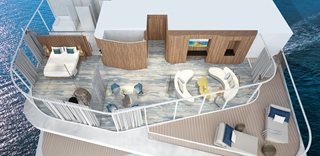
Category: PS
Amenities- Robes with optional personalization
- Complimentary premium refillable water bottle
- Daily delivery in-suite delectable
- Customized mini-bar offering
- Champagne / sparkling wine upon arrival
- Complimentary backpack
- Complimentary rain poncho
- Stationery
- Use of high-end marine binoculars
- Ecuadorian chocolates
- Use of sunglasses and readings glasses
- Local high-end, eco-friendly, organic bath amenities cooling gel, lip balm, sunscreen
- Largest, most luxurious suite in the Galápagos Islands
- Outward-facing spacious spa tub and shower
- King-sized bed
- Additional half bathroom
- Wraparound floor-to-ceiling windows
- Spa tub with floor-to-ceiling window
- Separate shower
- Spacious private veranda
- Full Suite automation
- In suite filtered water refilling station
- Premium linens and pillow menu
- Extensive offering of live and on demand TV programming and movies
- Personal Suite Attendant
- Laundry service twice per sailing*
- 24-hour in suite room service
- Full in-suite dinner service
- Laundry service twice per sailing
- Makeup and turndown services

Category: SL
Amenities- Complimentary premium refillable water bottle
- Daily delivery in-suite delectable
- Customized mini-bar offering
- Champagne / sparkling wine upon arrival
- Complimentary backpack
- Complimentary rain poncho
- Stationary
- Use of high-end marine binoculars
- Ecuadorian chocolates
- Use of sunglasses and readings glasses
- Local high-end, eco-friendly, organic bath amenities cooling gel, lip balm, sunscreen
- Outward-facing design
- Infinite Veranda
- King-sized bed
- Spacious shower
- Full Suite automation
- In-suite filtered water refilling station
- Premium linens and pillow menu
- Double-faucet vanity with stone countertop
- Extensive offering of live and on demand TV programming and movies
- Personal Suite Attendant
- 24-hour in-suite room service
- Full in-suite dinner service
- Makeup and turndown services

Category: S2
Amenities- Complimentary premium refillable water bottle
- Daily delivery in-suite delectable
- Customized mini-bar offering
- Champagne / sparkling wine upon arrival
- Complimentary backpack
- Complimentary rain poncho
- Stationery
- Use of high-end marine binoculars
- Ecuadorian chocolates
- Use of sunglasses and readings glasses
- Local high-end, eco-friendly, organic bath amenities cooling gel, lip balm, sunscreen
- Spacious veranda
- Outward facing design
- King-sized bed
- Spacious shower
- Full Suite automation
- Double faucet vanity with stone countertop
- In-suite filtered water refilling station
- Premium linens and pillow menu
- Extensive offering of live and on demand TV programming and movies
- Personal Suite Attendant
- Laundry service twice per sailing
- 24-hour in suite room service
- Full in-suite dinner service
- Laundry service twice per sailing*
- Makeup and turndown services

Category: S3
Amenities- Complimentary premium refillable water bottle
- Daily delivery in-suite delectable
- Customized mini-bar offering
- Champagne / sparkling wine upon arrival
- Complimentary backpack
- Complimentary rain poncho
- Stationery
- Use of high-end marine binoculars
- Ecuadorian chocolates
- Use of sunglasses and readings glasses
- Local high-end, eco-friendly, organic bath amenities cooling gel, lip balm, sunscreen
- Spacious veranda
- Outward facing design
- King-sized bed
- Spacious shower
- Full Suite automation
- Double faucet vanity with stone countertop
- In-suite filtered water refilling station
- Premium linens and pillow menu
- Extensive offering of live and on demand TV programming and movies
- Personal Suite Attendant
- Laundry service twice per sailing
- 24-hour in suite room service
- Full in-suite dinner service
- Laundry service twice per sailing*
- Makeup and turndown services

| Symbol | Description |
|---|
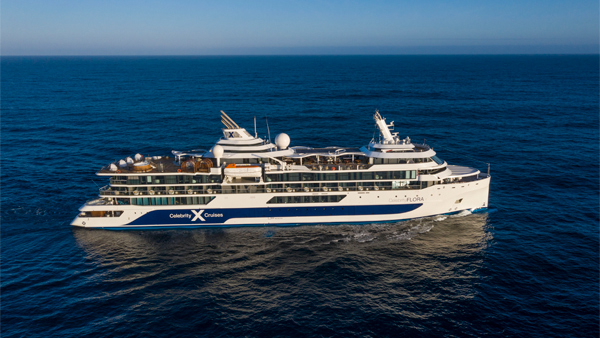
- Ship Name: Celebrity Flora
- Year Built: 2018
- Year Entered Present Fleet: 2019
- Ship Class: Expedition Series
- Maximum Capacity: 100
- Number of Passenger Decks: 6
- Number of Crew: 70
- Tonnage (GRT): 5,739
- Capacity Based on Double Occupancy: 100
- Country of Registry: Ecuador
- Total Staterooms: 50
- Suites with Balcony: 50
Costco Member Reviews

Terms & Conditions
*Price shown is per person based on double occupancy and is valid for select stateroom categories only. Click on the Terms & Conditions link below for details.
†One Digital Costco Shop Card per room/stateroom, per stay. The exact amount of the Digital Costco Shop Card will be calculated during the booking process. The Digital Costco Shop Card promotion is nontransferable and may not be combined with any other promotion. A Digital Costco Shop Card will arrive by email approximately 10 days after the start of your cruise. Click on the Terms & Conditions link below for additional information.
Ship's registry: Ecuador
Digital Costco Shop Card
Book this vacation or cruise with Costco Travel and receive a Digital Costco Shop Card. The Digital Costco Shop Card is a convenient payment option in our warehouses and on Costco.com.







